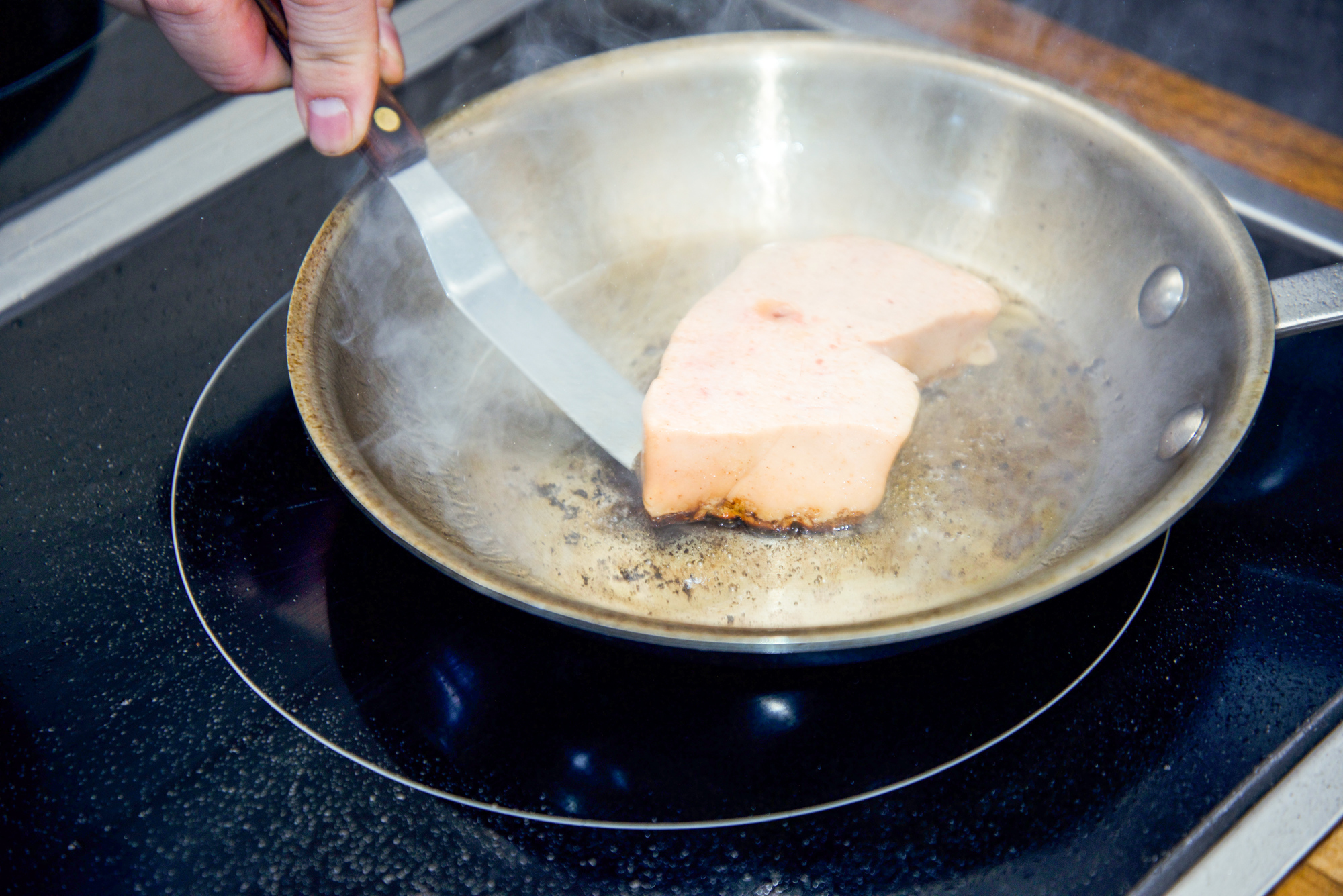In our cooking series Quickies, we invite chefs, bartenders, and other personalities in the world of food and drink who are serious hustlers to share their tips and tricks for preparing quick, creative after-work meals. Every dish featured in Quickies takes under 30 minutes to make, but without sacrificing any deliciousness—these are tried-and-tested recipes for the super-busy who also happen to have impeccable taste.
Ryan McCaskey is a chef who knows what he wants. Turns out, the chef-owner of Chicago’s Michelin-starred Acadia—who was born in Ho Chi Minh City and raised in the suburbs of Chicago—happens to have just a tiny thing for foie gras. So when McCaskey stopped by the MUNCHIES Test Kitchen a while back, he immediately knew what he wanted to make.
Videos by VICE
“I’m here to make seared foie gras with pancakes, mango, black truffle, and maple syrup. The dish basically came about because those were the only ingredients I had in my fridge,” explained McCaskey.

“I have done fine-dining versions of this on the tasting menu before, but to be honest, this dish stems from me being pretty drunk in the middle of the night and wanting bar food,” McCaskey told us.
We’re not really sure what bars McCaskey has been going to, but we couldn’t agree more.

“For whatever reason, my fridge at home has condiments, alcohol, and foie gras. That’s it. One night, I came home at three or four in the morning with my girlfriend at the time and we were starving. I basically threw this together because it was all that I had. Its super over the top, so it’s definitely not something I would make very often. It’s just one of those happy accidents.”
It’s a very happy, very decadent accident that thankfully is also pretty simple to make, when it comes down to it.

McClaskey is pretty discerning when it comes to his foie. “This is a lobe of grade-A Hudson Valley foie gras, so it’s not going to have many impurities. What I’m going to do is take some of the fat off of it and slice a portion. Late at night, you might as well have a pretty healthy portion of foie gras, which is a little out of control, but hey, that’s OK.”

After portioning your foie, McCaskey suggested scoring it to help render the fat—he used a light cross-hatch and warned us, “If you score your foie too deep, not only will your lobe likely fall apart, but you’re going to render out too much of the fat.”


Given that this is, essentially, late-night party food, McCaskey wasn’t going to be too precious about it. He explained, “To make the pancakes, just use your favorite box mix. Everything from a box is good enough for me, so don’t worry about making pancakes from scratch unless you really want to. Make sure you pour some melted butter in there so the edges become nice and crisp.”


While the pancake cooked, McCaskey seared the foie gras in a dry pan. “You want to pre-heat your pan ahead of time so your foie gets a nice crispy sear. That’s really important. Don’t worry about the smoke—foie gras is pretty much 100 percent fat, so that’s going to happen no matter what. It doesn’t mean you’re doing something wrong. You don’t even need to put anything in the pan because it renders quickly.”


McCaskey strongly advised against overcooking. “I’ll generally cook my foie gras to medium rare. I like having just a tiny bit of the inside be cool.”
Once he flipped the lobe over, he turned the heat down, and added a pinch of butter to the pan, basting it for about a minute and a half. “If you wanted to baste the foie in just its fat, you totally could, but I’m a butter freak,” he said.

But how do you know when it’s done? Just touch it.
“You have to feel your foie to know how cooked it is. Your foie gras will feel just slightly hard in the center when it gets to be medium rare. Honestly, one of the mistakes most people make when using foie gras is overcooking it.”

As the dish rested, McCaskey said, “Make sure you finish it with a little bit of Maldon or flake salt. Trust me, it really needs that pinch of salt.” Then he cut up mango, although he said blood orange, apricots, pears, or even peaches would work too.
Bottom line: “Make sure your dish looks nice. I take pride in everything I cook, even if it’s three in the morning and I’m drunk.”


He wasn’t not quite done yet, though: “I like to finish off the dish with just a little bit of truffle product, either truffle paste or oil. Just a tiny bit around the plate. Even at home I like to pretend I’m fancy. Lastly, to put this entire dish over the top, add some really [high-quality] maple syrup.”


McCaskey said you can eat this dish any time, “You would probably be best off eating this late at night, but I guess you could have it for breakfast if you wanted to go a bit crazy.” And don’t forget to save the rendered fat, which McCaskey said he used to use at his restaurant to sous vide salmon bellies.

OK seriously, we’re just about done, but there is this final bit of advice: “I would drink some nice whiskey with this. In fact, it pairs really nice with some bourbon.”

Not a bad dish to come home to after a late night of debauchery. Or anytime.
Ryan McCaskey is the chef and proprietor of Chicago’s Michelin-starred Acadia restaurant.




